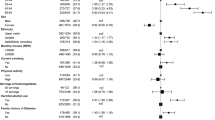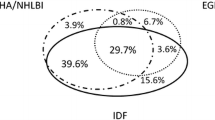Abstract
Objectives
The purpose of this study was to compare the prevalence of metabolic syndrome diagnosed, using four different definitions in the Lithuanian urban population, and determine their association with ischemic heart disease.
Methods
Data from the survey performed in the framework of the HAPIEE (Health, Alcohol, and Psychosocial factors In Eastern Europe) study were presented. A random sample of 7087 individuals aged 45–72 years was screened in 2006–2008.
Results
In Kaunas city, Lithuania, the highest prevalence of metabolic syndrome, in the urban population aged 45–72 years, was determined according to the new Joint Interim Societies (JIS) definition (44.1% of men and 48.7% of women). After adjusting for age, education, and smoking habits, the metabolic syndrome (irrespective of definition) was associated with a significantly higher risk of ischemic heart disease.
Conclusion
All four metabolic syndrome definitions were associated with ischemic heart disease risk; however, the odds of this disease were higher in people with the metabolic syndrome as defined by the American Heart Association/National Heart Lung Blood Institute and the National Cholesterol Education Program Adult Treatment Panel III than by the new JIS definition.

Similar content being viewed by others
References
Adams RJ, Appleton S, Wilson DH, Taylor AW, Grande ED, Chittleborough C et al (2005) Population comparison of two clinical approaches to the metabolic syndrome. Implications of the new International Diabetes Federation consensus definition. Diabetes Care 28:2777–2779
Ahmad OB, Boschi-Pinto C, Lopez AD, Murray CJL, Lozano R, Inoue M (2001) Age standardization of rates: a new WHO standard (GPE Discussion Paper No. 31). WHO, Geneva (Switzerland)
Alberti KG, Eckel RH, Grundy SM, Zimmet PZ, Cleeman JI, Donato KA et al (2009) Harmonizing the metabolic syndrome: a joint interim statement of the International Diabetes Federation Task Force on Epidemiology and Prevention; National Heart, Lung, and Blood Institute; American Heart Association; World Heart Federation; International Atherosclerosis Society; and International Association for the Study of Obesity. Circulation 120:1640–1645
Athyros VG, Ganotakis ES, Elisaf MS, Liberopoulos EN, Goudevenos IA, Karagiannis A (2007) Prevalence of vascular disease in metabolic syndrome using three proposed definitions. Int J Cardiol 117:204–210
Athyros VG, Ganotakis ES, Tziomalos K, Papageorgiou AA, Anagnostis P, Griva T et al (2010) Comparison of four definitions of the metabolic syndrome in a Greek (Mediterranean) population. Curr Med Res Opin 26:713–719
Buckland G, Salas-Salvadó J, Roure E, Bulló M, Serra-Majem L (2008) Sociodemographic risk factors associated with metabolic syndrome in a Mediterranean population. Public Health Nutr 11:1372–1378
Cerniauskiene LR, Reklaitiene R, Luksiene DI, Domarkiene S, Tamosiunas A, Margevicienė L (2005) Association of metabolic syndrome with ischemic heart disease among middle-aged Kaunas population. Medicina (Kaunas) 41:435–441
Cerniauskiene LR, Luksiene DI, Tamosiunas A, Reklaitiene R, Margeviciene L (2008) Association of metabolic syndrome and oxidative stress with ischemic heart disease in middle-aged persons. Medicina (Kaunas) 44:392–399
Daskalopoulou SS, Athyros VG, Kolovou GD, Anagnostopoulou KK, Mikhailidis DP (2006) Definitions of metabolic syndrome: where are we now? Curr Vasc Pharmacol 4:185–197
Day C (2007) Metabolic syndrome, or what you will: definitions and epidemiology. Diab Vasc Dis Res 4:32–38
Eckel RH, Alberti KG, Grundy SM, Zimmet PZ (2010) The metabolic syndrome. Lancet 375:181–183
Eddy DM, Schlessinger L, Heikes K (2008) The metabolic syndrome and cardiovascular risk: implications for clinical practice. Int J Obes (Lond) 32:S5–S10
Ford ES (2005) Prevalence of the metabolic syndrome defined by the International Diabetes Federation among adults in the US. Diabetes Care 28:2745–2749
Grundy SM, Cleeman JI, Daniels SR, Donato KA, Eckel RH, Franklin BA et al (2005) Diagnosis and management of the metabolic syndrome: an American Heart Association/National Heart, Lung, and Blood Institute Scientific Statement. Circulation 112:2735–2752
Health Statistics of Lithuania 2009 (2010) Lithuanian Ministry of Health Information Centre of Institute of Hygiene, Vilnius
Li WJ, Xue H, Sun K, Song XD, Wang YB, Zhen YS, Han YF, Hui RT (2008) Cardiovascular risk and prevalence of metabolic syndrome by differing criteria. Chin Med J (Engl) 121:1532–1536
Lorenzo C, Williams K, Hunt KJ, Haffner SM (2007) The National Cholesterol Education Program-Adult Treatment Panel III, International Diabetes Federation, and World Health Organization definitions of the metabolic syndrome as predictors of incident cardiovascular disease and diabetes. Diabetes Care 30:8–13
Luksiene DI, Cerniauskiene LR, Margeviciene L, Tamosiunas A (2008) Changes in the prevalence of metabolic syndrome and smoking habits during a 10-year period and relation between these risk factors and ischemic heart disease among men aged 45–64 years. Medicina (Kaunas) 44:400–406
Luksiene DI, Baceviciene M, Tamosiunas A, Cerniauskiene LR, Margeviciene L, Reklaitiene R (2010) Prevalence of the metabolic syndrome diagnosed using three different definitions and risk of ischemic heart disease among Kaunas adult population. Medicina (Kaunas) 46:61–69
McNeill AM, Rosamond WD, Girman CJ, Golden SH, Schmidt MI, East HE et al (2005) The metabolic syndrome and 11-year risk of incident cardiovascular disease in the atherosclerosis risk in communities study. Diabetes Care 28:385–390
Nilsson PM, Engström G, Hedblad B (2007) The metabolic syndrome and incidence of cardiovascular disease in non-diabetic subjects-a population-based study comparing three different definitions. Diabet Med 24:464–472
Norkus A, Ostrauskas R, Sulcaitė R, Baranauskiene E, Baliutaviciene D (2000) Classification and diagnostics of diabetes mellitus (Methodology recommendations). Lithuanian Endocrinol 3,4:234–241
Peasey A, Bobak M, Kubinova R, Malyutina S, Pajak A, Tamosiunas A, Pikhart H, Nicholson A, Marmot M (2006) Determinants of cardiovascular diseases and other non-communicable diseases in Central and Eastern Europe: rationale and design of the HAPIEE study. BMC Public Health. doi:10.1186/1471-2458-6-255
Prineas RJ, Crow RS, Blackburn H (1982) The Minnesota Code manual of electrocardiographic findings. John Wright, London
Rose GA, Blackburn H, Gillum RF, Prineas RJ (1982) Cardiovascular survey methods. Cardiovascular Disease Unit, WHO, Geneva (Switzerland)
Santos AC, Ebrahim S, Barros H (2008) Gender, socio-economic status and metabolic syndrome in middle-aged and old adults. BMC Public Health 8:62
Third Report of the National Cholesterol Education Program (NCEP) expert panel on detection, evaluation and treatment of high blood cholesterol in adults (Adult Treatment Panel III) final report (2002) Circulation 106:3143–3421
Wilson PW, D’Agostino RB, Parise H, Sullivan L, Meigs JB (2005) Metabolic syndrome as a precursor of cardiovascular disease and type 2 diabetes mellitus. Circulation 112:3066–3072
Zimmet P, Alberti KG, Serrano Rios M (2005) A new International Diabetes Federation (IDF) worldwide definition of the metabolic syndrome: the rationale and the results. Rev Esp Cardiol 58:1371–1376
Acknowledgments
The HAPIEE study is funded by grants from the Wellcome Trust (grant no.064947/Z/01/Z), the US National Institute on Aging (grant no. IR0I AG23522-01) and the MacArthur Foundation (Health and Social Upheaval network).
Conflict of interest
None.
Author information
Authors and Affiliations
Corresponding author
Rights and permissions
About this article
Cite this article
Luksiene, D.I., Baceviciene, M., Tamosiunas, A. et al. Comparison of four definitions of the metabolic syndrome and odds of ischemic heart disease in the Lithuanian urban population. Int J Public Health 57, 543–550 (2012). https://doi.org/10.1007/s00038-011-0244-x
Received:
Revised:
Accepted:
Published:
Issue Date:
DOI: https://doi.org/10.1007/s00038-011-0244-x




